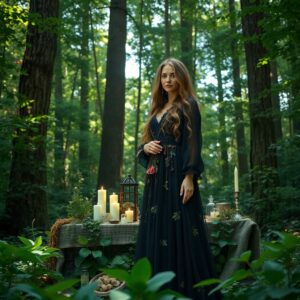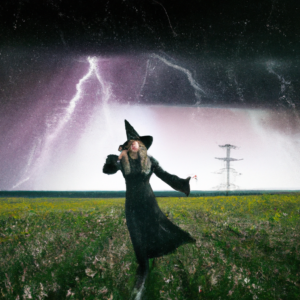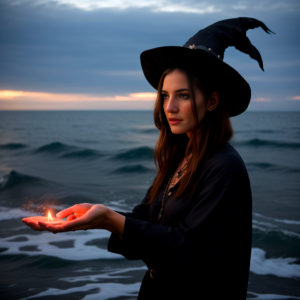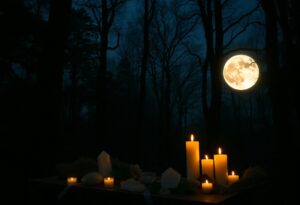
New to Witchcraft?
There’s a rich history of witchcraft that dates back centuries, with roots in various cultures and traditions. Today, many new-age witches embrace a belief system centered around honoring the Wheel of the Year, which marks the changing seasons and cycles of nature. This practice involves celebrating the solstices, equinoxes, and other important days throughout the year.
For those just starting out on their witchcraft journey, incorporating simple spells and rituals can be a great way to connect with the spiritual world. Easy spells such as protection spells, manifestation spells, and cleansing rituals can help beginners get a feel for working with energy and intention.
As a new witch, it’s important to remember that witchcraft is a personal practice that can mean different things to different people. Whether you choose to follow traditional witchcraft practices or forge your own path, the most important thing is to stay true to yourself and your beliefs. Embrace the magic that surrounds you and let it guide you on your journey to becoming a powerful and enlightened witch.
Key Takeaways:
Honoring the Wheel of the Year: As a new witch, it is important to familiarize yourself with the eight Sabbats and their significance in nature’s cycle. Embrace the changing seasons and harness their energy for spells and rituals.
Easy Spells: Start with simple spells like protection charms, abundance rituals, and manifestation spells. These spells are beginner-friendly and can help you build confidence in your magical practice.
History of Witchcraft: Study the rich history of witchcraft, from ancient times to the modern era. Understand the persecution faced by witches and the evolution of magical practices over the centuries.
Beliefs of a New-Age Witch: Embrace a blend of ancient wisdom and modern spirituality. New-age witches often incorporate elements of nature-based religions, energy work, and mindfulness practices in their craft.
Exploration and Experimentation: Don’t be afraid to explore different paths within witchcraft and find what resonates with you. Experiment with different spells, rituals, and traditions to create a personalized practice that aligns with your beliefs and intentions.
The Roots of Witchcraft
A Brief History
Any discussion of witchcraft must acknowledge its rich and complex history. Witchcraft is deeply rooted in ancient traditions, dating back to pre-Christian times when healers and wise women were revered in society. However, the term “witchcraft” became associated with negative connotations during the medieval period when the Church demonized practitioners of folk magic and herbal healing. The infamous witch hunts of the 16th and 17th centuries led to the persecution and execution of countless innocent individuals accused of witchcraft.
Evolution of Witchcraft Practices
Evolution of Witchcraft Practices
Any as modern witchcraft has gained popularity in recent decades, it has evolved to encompass a wide array of practices and beliefs. Modern witches draw inspiration from various spiritual traditions, including Wicca, astrology, and indigenous folk practices. Many contemporary witches also incorporate elements of feminism, environmentalism, and social justice into their spiritual practice. The focus is often on self-empowerment, healing, and connecting with the natural world.
Understanding the New-Age Witch
Even for those new to witchcraft, understanding the beliefs and values of the new-age witch is imperative. These individuals are deeply connected to nature, honoring the Wheel of the Year which celebrates the different seasons and their significance. They believe in the power of energy and intention, often harnessing these forces through rituals and spells. New witches also prioritize self-care and self-discovery, viewing witchcraft as a tool for personal growth and empowerment.
Beliefs and Values
For new-age witches, their beliefs and values revolve around the idea of interconnectedness with the world around them. They hold deep respect for nature and all living beings, believing in the power of intuition and energy manipulation. These individuals often practice mindfulness and meditation to stay grounded and connected to their inner selves. The core belief of a new-age witch is that everything is connected through energy, and by harnessing this energy, they can create positive change in their lives and the world.
The Spectrum of Witchcraft
New-age witchcraft encompasses a wide spectrum of practices and beliefs, ranging from traditional witchcraft to modern eclectic approaches. Some may focus on herbalism and natural remedies, while others may explore into divination or energy healing. The beauty of modern witchcraft is that it allows individuals to personalize their practices and beliefs to suit their own spiritual journey. Whether casting spells, working with crystals, or honoring deities, new-age witches have the flexibility to tailor their craft to their unique preferences and beliefs.
The Wheel of the Year
All witches, new and experienced, honor the Wheel of the Year, which represents the cycle of the seasons. This cycle is marked by eight Sabbats, or high holidays, and thirteen Esbats, or lunar celebrations. Understanding and connecting with the energy of the Wheel of the Year is fundamental to practicing witchcraft and harnessing its power.
Sabbats – The High Holidays
Holidays such as Samhain, Beltane, and Lammas are sacred times during which witches commemorate the changing seasons and honor the Earth’s cycles. Each Sabbat has its own unique traditions and symbolism, from the somber introspection of Samhain to the joyful celebration of Beltane. By observing these holidays, witches align themselves with the natural rhythms of the universe and draw strength from the Earth’s energies.
Esbats – The Lunar Celebrations
Especially significant to witches are the full moons and new moons, known as Esbats. These lunar celebrations are times for reflection, ritual, and spellwork. Witches often gather under the light of the moon to honor its power and set intentions for the lunar cycle ahead. By connecting with the moon’s phases, new witches can deepen their understanding of the cosmic forces at work in their practice.
Among the Esbats, Beltane is a particularly potent time for witches to harness the fecundity and vitality of spring. This holiday, celebrated on May 1st, is associated with fertility, growth, and passion. Witches may perform rituals to fertilize their dreams and intentions, or simply revel in the abundance of nature that surrounds them during this sacred time.
Creating Sacred Space
Altars and Their Significance
For new witches delving into magic, creating a sacred space is important. Altars, often the focal point of this sacred space, serve as a physical representation of your connection to the divine. Significance is placed on carefully selecting items that hold personal meaning, such as crystals, candles, and symbols representing the elements. Your altar is where you can concentrate your energy and intentions, making it a powerful tool for manifestation and ritual work.
Tools of the Craft
An important part of a witch’s practice is the tools used in spellwork and ceremony. An altar may be adorned with items like a wand, crystals, herbs, and a cauldron. These tools are not just for decoration; they are instruments of power that help focus your intentions and harness the energy around you. Each tool has a specific purpose and can enhance your magical practice.
From a wand for directing energy to a mortar and pestle for grinding herbs, having the right tools can elevate your spellwork to new heights. While it’s important to remember that the power ultimately comes from within you, the tools of the craft can aid in channeling your energy and connecting with the spiritual forces you are working with.
Communing with Nature
Your journey as a witch begins with connecting to the natural world around you. Nature is a powerful source of energy and magic, and by immersing yourself in it, you can enhance your own abilities and deepen your spiritual practice.
Herbs and Their Uses
With a rich history in healing and magic, herbs are crucial tools for any witch. Each herb possesses its own unique properties and energies that can be harnessed for various purposes, such as protection, healing, and manifestation. Some common herbs like sage, lavender, and rosemary can be easily found in stores or grown in your garden, making them accessible for beginners.
Crystals and Stones for Beginners
With their natural energies and vibrations, crystals and stones have been used in witchcraft for centuries. Crystals like amethyst, quartz, and citrine are popular choices for beginners due to their versatility and ease of use. When choosing a crystal, trust your intuition and select one that resonates with you.
Beginners often start by using crystals for protection, clarity, and amplifying intentions. Crystals can be incorporated into spells, rituals, or simply carried with you to benefit from their energies throughout the day. Remember to cleanse and charge your crystals regularly to keep their energies pure and potent.
Spellcasting Basics
Understanding Intention and Visualization
Not all spells require complicated rituals or rare ingredients. The key to successful spellcasting lies in understanding the power of intention and visualization. Before casting a spell, it is necessary to clearly define your intention and visualize the desired outcome in your mind. This focus and clarity will help channel your energy towards manifesting your desires.
On a deeper level, intention acts as the driving force behind spellcasting, and visualization serves as the bridge between the physical and spiritual realms. By aligning your thoughts and emotions with your intention, you can harness the transformative power of magic to bring about positive change in your life.
Incorporating intention and visualization into your spellcasting practice not only enhances the effectiveness of your spells but also deepens your connection to the forces of nature and the universe, aligning you with the principles of the Wheel of the Year.
Simple Spells to Get Started
With a solid understanding of intention and visualization, you can now begin practicing simple spells to get started on your magical journey. Start with basic spells for protection, abundance, and healing to build your confidence and skills. Utilize everyday objects like candles, herbs, and crystals to enhance the potency of your spells.
Spellcasting is a powerful tool that allows you to manifest your desires and create positive change in your life and surroundings. Remember to always approach spellcasting with respect and mindfulness, as every action has consequences in magic. As you gain experience and mastery in spellcasting, you will witness the profound impact it can have on your life.
Spellcasting is a sacred art that requires dedication, practice, and a deep connection to the energies of the universe. By honing your skills in intention and visualization and exploring the world of simple spells, you can begin on a transformative journey of self-discovery and empowerment as a practitioner of modern witchcraft.
Connecting with Deities
Despite the diverse range of deities present in different pantheons around the world, new witches often find themselves drawn to particular ones that resonate with them on a personal level. Exploring different pantheons can be a fascinating journey of discovery, as each deity carries unique attributes and symbolism. On the one hand, you may feel a connection with Greek gods and goddesses such as Zeus or Athena, known for their wisdom and power. On the other hand, you may be drawn to Egyptian deities like Isis or Anubis, revered for their guidance and protection.
Exploring Different Pantheons
On this journey of exploration, it’s important to research and learn about the mythology and traditions of the pantheons you are interested in. Understanding the history and characteristics of different deities will help you establish a deeper connection with them. For example, if you feel drawn to Norse mythology, you may resonate with Odin, the Allfather, known for his wisdom and magic. Alternatively, if you are intrigued by Celtic mythology, you may connect with Brigid, the goddess of healing and creativity.
Developing Relationships with Deities
For new witches, developing relationships with deities can be a transformative experience that enhances their spiritual practice. This involves honoring and working with specific deities through rituals, offerings, and meditations. It’s crucial to approach these relationships with respect and sincerity, acknowledging the power and guidance that the deities offer. This connection can bring about profound insights, protection, and blessings in your magical journey.
This journey of connecting with deities is a personal and sacred path that can enrich your practice as a witch. Through devotion and honoring deities that resonate with you, you can experience a deeper sense of connection and empowerment in your magical workings. Embrace this opportunity to nurture and strengthen your spiritual relationship with the divine energies that surround you.
Developing Your Intuition
Many individuals who are new to witchcraft often seek to develop their intuition as a foundational skill in their practice. Cultivating one’s intuition can enhance one’s magical abilities and connection to the spiritual realm. One effective way to hone this skill is through meditation practices, which allow for deep introspection and connection with one’s inner self.
Meditation Practices
Practices such as mindfulness meditation, visualization, and breathwork are particularly effective for enhancing intuition. Mindfulness meditation involves focusing on the present moment and observing one’s thoughts without judgment. Visualization allows practitioners to create mental images that can enhance their intuitive abilities. Breathwork techniques, such as deep breathing exercises, can help calm the mind and enhance focus during meditation.
Psychic Development Exercises
The practice of psychic development exercises is another method for new witches to enhance their intuition. These exercises often involve practices such as aura reading, psychometry, and telepathy. Aura reading involves sensing and interpreting the energy fields surrounding individuals, while psychometry involves reading the energy of objects. Telepathy exercises focus on developing the ability to communicate through thoughts and mental images.
Psychic development exercises can be powerful tools for new witches seeking to strengthen their intuitive abilities. However, it is necessary to approach these practices with caution and respect, as they can open one up to unseen energies and influences. Consistent practice, patience, and a willingness to explore and expand one’s boundaries are key to developing one’s intuition as a new witch.
Ethics and Responsibilities
The Wiccan Rede
Once again, ethics and responsibilities play a crucial role in the practice of witchcraft. The Wiccan Rede, a statement that many witches adhere to, embodies the central ethical principle of ‘An it harm none, do what you will’. This necessaryly means that as long as your actions do not cause harm to others, you are free to pursue your intentions.
Wiccan practitioners believe that following the Wiccan Rede contributes to a harmonious existence not only for themselves but for the world around them. By considering the potential impact of their actions on others, Wiccans strive to uphold a higher level of consciousness and moral integrity in their magical practices.
Through embracing the Wiccan Rede, new witches can find guidance in making ethical decisions and ensure that their magical workings align with the principles of love and positivity. It serves as a reminder to approach spellcasting and rituals with mindfulness and consideration for all beings.
The Law of Threefold Return
On the other hand, the Law of Threefold Return is another important ethical concept in witchcraft that emphasizes the idea that whatever energy a person puts out into the world, whether positive or negative, will be returned to them threefold. This belief reinforces the notion that one’s actions carry consequences and that one must be mindful of the energy they project.
Threefold Return warns that any harm done will come back three times stronger, but conversely, any good deeds will also be rewarded threefold. It serves as a powerful reminder to always remain conscious of the impact of one’s actions, not only for personal growth but also for the greater good of the community and the Earth.
Joining the Witch Community
Finding Like-Minded Individuals
Keep in mind that launching on a journey into witchcraft can be a deeply personal and spiritual experience. However, connecting with others who share similar beliefs and practices can be incredibly enriching and fulfilling. To find like-minded individuals, consider joining online forums, attending local meetups, or participating in workshops and classes focused on witchcraft and the occult. Social media platforms, such as Instagram and Facebook, also offer numerous groups and communities where you can engage with fellow witches.
By interacting with others in the witch community, you can exchange knowledge, experiences, and support on your path. It’s important to approach these interactions with openness and respect, as diversity is a key aspect of the witch community. Remember that each individual’s practice is unique and valid, and there is much to learn from the varied perspectives within the community. Building connections with like-minded individuals can help you feel supported and inspired as you navigate your journey into witchcraft.
Covens vs. Solitary Practice
Covens and solitary practice are two main paths within the witch community. Covens are groups of witches who come together to practice rituals, celebrate the Wheel of the Year, and support one another in their magical endeavors. Joining a coven can provide a sense of community and shared tradition, as well as structured learning opportunities. However, some witches prefer solitary practice, where they explore their craft and spirituality on their own terms, without the constraints of group dynamics.
Deciding between a coven and solitary practice is a personal choice that depends on your preferences and spiritual goals. Some witches may choose to experiment with both paths before settling on one that resonates most with them. Whether you prefer the camaraderie of a coven or the independence of solitary practice, remember that there is no right or wrong way to practice witchcraft. What matters most is honoring your own beliefs and intuition on your sacred journey.
Resources for Further Learning
Books and Authors to Explore
Many new witches often seek guidance from books that probe into the history, practices, and beliefs of witchcraft. An excellent starting point is “Wicca: A Guide for the Solitary Practitioner” by Scott Cunningham, which provides a comprehensive overview of Wiccan practices and rituals. Another recommended read is “The Spiral Dance” by Starhawk, a classic text that explores the intersections of feminism and witchcraft. These authors offer valuable insights and inspiration for those beginning their journey into the world of witchcraft.
Online Resources and Communities
Online platforms and communities have become invaluable resources for new witches seeking support and guidance. These spaces offer a wealth of information, from beginner spellcasting tips to in-depth discussions on honoring the Wheel of the Year. One popular website is Witches of the Craft, which features articles, rituals, and forums where practitioners can connect with like-minded individuals. Joining online communities can provide new witches with a sense of belonging and a place to share experiences and knowledge.
Authors and online resources play a crucial role in guiding new witches on their spiritual journey. By exploring the works of esteemed authors and engaging with online communities, individuals can deepen their understanding of witchcraft practices and connect with a supportive network of fellow practitioners.
Rituals and Rites of Passage
Self-Initiation into Witchcraft
To fully immerse yourself in the world of witchcraft, self-initiation can be a powerful and meaningful experience. Any individual can declare themselves a witch and initiate their journey by committing to honoring the Wheel of the Year. This involves celebrating eight major Sabbats that mark the changing of seasons and harvests, connecting with nature, and embracing the cyclical nature of life.
One way to self-initiate is by creating a personal ritual or ceremony that reflects your dedication and intention to walk the magical path. Anointing yourself with special oils, meditating, and casting a simple but intentional spell can help solidify your commitment. It is important to approach self-initiation with reverence and respect, as it marks the beginning of a significant spiritual journey.
Other Rites of Passage
Another important aspect of witchcraft is the acknowledgment and celebration of various rites of passage throughout one’s life. An initiation ceremony performed by a mentor or coven can be a profound experience for new witches, marking their formal acceptance into the magical community. Other rites of passage may include dedication rituals, handfasting ceremonies, and rites of transition such as birth, marriage, and death.
With the guidance of experienced witches and a deep connection to the natural world, newcomers can navigate these rites with reverence and grace. Embracing these milestones can deepen one’s spiritual practice and foster a sense of belonging within the broader witchcraft community.
Addressing Challenges
Overcoming Stereotypes
Now, as a new witch delving into the world of witchcraft, you may face challenges and stereotypes. It’s important to remember that witchcraft is a diverse and complex practice, rooted in ancient traditions and beliefs. Many misconceptions surround witchcraft, from being associated with evil to being seen as nothing more than a fantasy. But as a new-age witch, you have the power to dispel these myths and educate others on the true essence of witchcraft. In order to overcome these stereotypes and challenges, knowledge and understanding are key. Knowing the history of witchcraft, the different beliefs and practices, and honoring the Wheel of the Year can empower you to stand strong in your craft. By embracing the beauty and power of nature, you can connect with the energies around you and dispel any negativity that comes your way. Here’s a breakdown of the Wheel of the Year to get you started:
Wheel of the Year Description
Samhain A time to honor ancestors and reflect on the cycle of life and death
Yule Celebrate the Winter Solstice and rebirth of the sun
Imbolc Mark the halfway point between the Winter Solstice and Spring Equinox
Ostara Embrace the balance of light and dark as spring begins
Beltane Celebrate fertility and the beauty of life during the peak of spring
Protecting Your Energy
For new witches, protecting your energy is crucial in maintaining a positive and healthy practice. This involves setting boundaries, cleansing your space regularly, and practicing self-care rituals. By creating a sacred space for yourself and focusing on techniques such as meditation and grounding, you can shield yourself from negative energies. This process may involve using protective crystals, performing energy cleansing spells, and setting intentions for your practice. By surrounding yourself with positivity and light, you can ward off any unwanted energy and maintain a harmonious balance in your craft. Bear in mind, your energy is sacred, and protecting it is imperative for your growth and success as a witch.
Navigating the Modern World as a Witch
Balancing Tradition with Innovation
After entering into the world of witchcraft, you may find yourself torn between honoring ancient traditions and embracing modern innovations. It’s important to remember that witchcraft is a constantly evolving practice, shaped by both the past and the present. As a new witch, it’s vital to find a balance between honoring the Wheel of the Year – the eight seasonal festivals celebrated by many witches – and incorporating new ideas and practices into your craft.
Many new-age witches believe in the power of adapting and evolving their practice to suit their own unique beliefs and experiences. By blending traditional rituals with innovative approaches, you can create a practice that feels authentic and meaningful to you. Don’t be afraid to explore new paths and experiment with different techniques – witchcraft is a deeply personal journey, and there is no one-size-fits-all approach.
The Role of Technology in Witchcraft
Navigating the role of technology in witchcraft can be both exciting and challenging. For instance, technology has made it easier than ever for witches to connect with each other, access educational resources, and participate in virtual rituals and ceremonies. However, it’s important to approach technology mindfully and with intention, ensuring that it enhances rather than detracts from your spiritual practice.
To wrap up
With these considerations, new witches can confidently launch on their journey into the world of witchcraft. By honoring the Wheel of the Year, they can connect with the natural cycles of the Earth and harness the power of each season to enhance their spiritual practices. Taking the time to celebrate Sabbats and Esbats can help new witches feel more in tune with the energy around them and deepen their connection to the earth.
In the context of spellcasting, new witches can start with simple practices such as visualization exercises, candle magic, and crystal work. These beginner-friendly spells can help new witches hone their magical skills and build their confidence in their abilities. By starting small and gradually expanding their repertoire, new witches can slowly build their magical practice and find what resonates most with them.
Overall, new-age witches believe in the power of intention, energy, and interconnectedness. They embrace diversity, practice kindness, and strive for balance in all aspects of their lives. As new witches explore their beliefs and hone their craft, they will find a sense of empowerment, connection, and wonder that will guide them on their spiritual journey for years to come.
FAQ
Q: What is witchcraft?
A: Witchcraft is a spiritual practice that involves harnessing the natural energies of the earth and utilizing them to create positive changes in one’s life.
Q: How can I start practicing witchcraft as a beginner?
A: As a beginner, you can start practicing witchcraft by learning about the basic concepts, traditions, and tools used in the craft. You can also start by setting intentions, meditating, and connecting with the elements.
Q: What is the Wheel of the Year and why is it important in witchcraft?
A: The Wheel of the Year is a calendar that marks the changing seasons and the natural cycles of the earth. It is important in witchcraft as it helps practitioners align with the energies of nature and celebrate significant festivals and rituals throughout the year.
Q: What are some easy spells for beginners to try?
A: Some easy spells for beginners to try include candle magic for manifestation, sachet spells for protection, and simple rituals for setting intentions or releasing negative energy.
Q: What do new-age witches believe in?
A: New-age witches typically believe in the interconnectedness of all living beings, the power of intention and manifestation, and the importance of honoring the earth and its natural cycles. They may also incorporate elements of astrology, crystal healing, and energy work into their practice.






